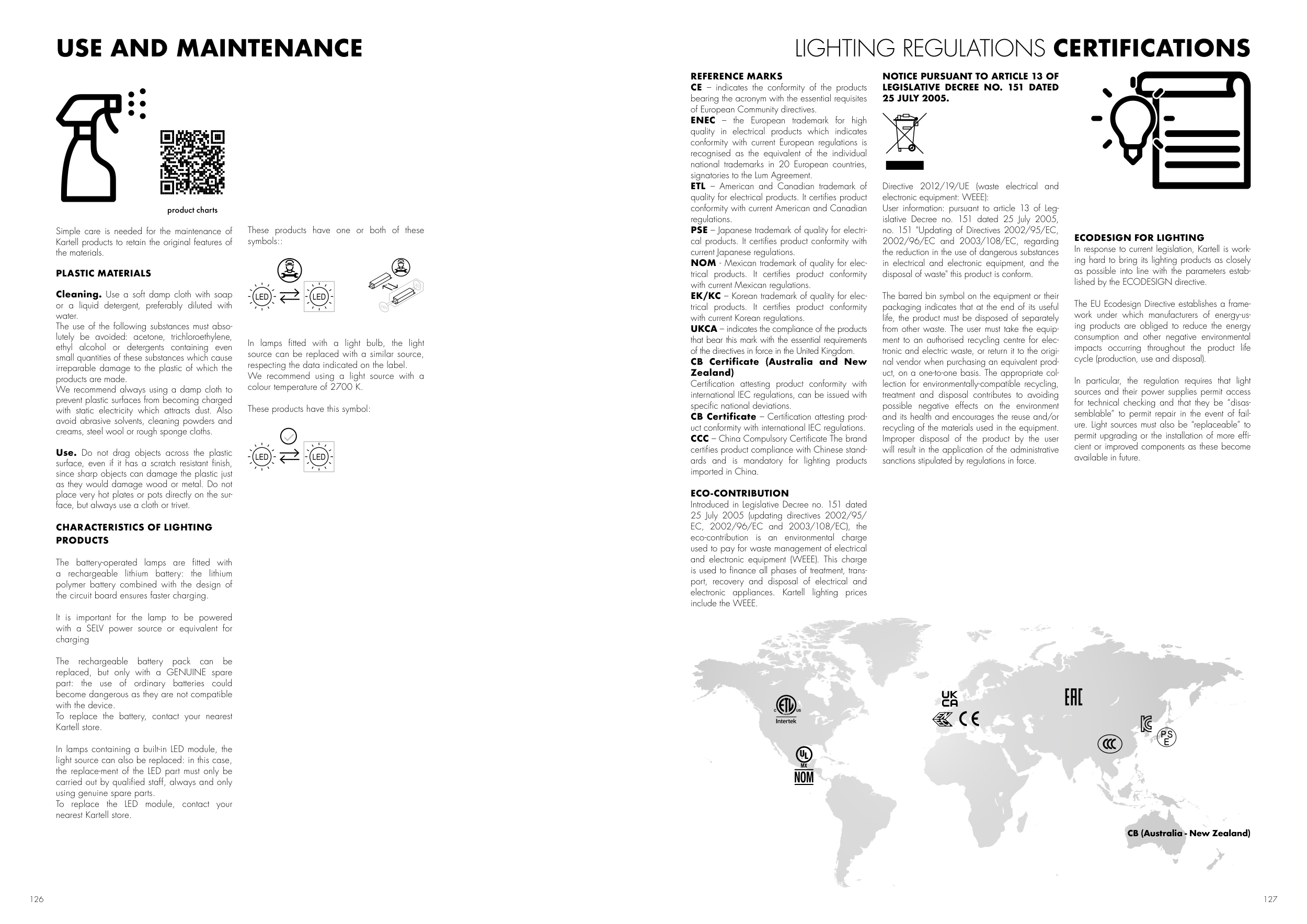126
Simple care is needed for the maintenance of
Kartell products to retain the original features of
the materials.
PLASTIC MATERIALS
Cleaning. Use a soft damp cloth with soap
or a liquid detergent, preferably diluted with
water.
The use of the following substances must abso-
lutely be avoided: acetone, trichloroethylene,
ethyl alcohol or detergents containing even
small quantities of these substances which cause
irreparable damage to the plastic of which the
products are made.
We recommend always using a damp cloth to
prevent plastic surfaces from becoming charged
with static electricity which attracts dust. Also
avoid abrasive solvents, cleaning powders and
creams, steel wool or rough sponge cloths.
Use. Do not drag objects across the plastic
surface, even if it has a scratch resistant finish,
since sharp objects can damage the plastic just
as they would damage wood or metal. Do not
place very hot plates or pots directly on the sur-
face, but always use a cloth or trivet.
CHARACTERISTICS OF LIGHTING
PRODUCTS
The battery-operated lamps are fitted with
a rechargeable lithium battery: the lithium
polymer battery combined with the design of
the circuit board ensures faster charging.
It is important for the lamp to be powered
with a SELV power source or equivalent for
charging
The rechargeable battery pack can be
replaced, but only with a GENUINE spare
part: the use of ordinary batteries could
become dangerous as they are not compatible
with the device.
To replace the battery, contact your nearest
Kartell store.
In lamps containing a built-in LED module, the
light source can also be replaced: in this case,
the replace-ment of the LED part must only be
carried out by qualified staff, always and only
using genuine spare parts.
To replace the LED module, contact your
nearest Kartell store.
These products have one or both of these
symbols::
In lamps fitted with a light bulb, the light
source can be replaced with a similar source,
respecting the data indicated on the label.
We recommend using a light source with a
colour temperature of 2700°K.
These products have this symbol:
USE AND MAINTENANCE
product charts
127
CB (Australia - New Zealand)
LIGHTING REGULATIONS CERTIFICATIONS
REFERENCE MARKS
CE – indicates the conformity of the products
bearing the acronym with the essential requisites
of European Community directives.
ENEC – the European trademark for high
quality in electrical products which indicates
conformity with current European regulations is
recognised as the equivalent of the individual
national trademarks in 20 European countries,
signatories to the Lum Agreement.
ETL – American and Canadian trademark of
quality for electrical products. It certifies product
conformity with current American and Canadian
regulations.
PSE – Japanese trademark of quality for electri-
cal products. It certifies product conformity with
current Japanese regulations.
NOM - Mexican trademark of quality for elec-
trical products. It certifies product conformity
with current Mexican regulations.
EK/KC – Korean trademark of quality for elec-
trical products. It certifies product conformity
with current Korean regulations.
UKCA – indicates the compliance of the products
that bear this mark with the essential requirements
of the directives in force in the United Kingdom.
CB Certificate (Australia and New
Zealand)
Certification attesting product conformity with
international IEC regulations, can be issued with
specific national deviations.
CB Certificate – Certification attesting prod-
uct conformity with international IEC regulations.
CCC – China Compulsory Certificate The brand
certifies product compliance with Chinese stand-
ards and is mandatory for lighting products
imported in China.
ECO-CONTRIBUTION
Introduced in Legislative Decree no. 151 dated
25 July 2005 (updating directives 2002/95/
EC, 2002/96/EC and 2003/108/EC), the
eco-contribution is an environmental charge
used to pay for waste management of electrical
and electronic equipment (WEEE). This charge
is used to finance all phases of treatment, trans-
port, recovery and disposal of electrical and
electronic appliances. Kartell lighting prices
include the WEEE.
NOTICE PURSUANT TO ARTICLE 13 OF
LEGISLATIVE DECREE NO. 151 DATED
25 JULY 2005.
Directive 2012/19/UE (waste electrical and
electronic equipment: WEEE):
User information: pursuant to article 13 of Leg-
islative Decree no. 151 dated 25 July 2005,
no. 151 "Updating of Directives 2002/95/EC,
2002/96/EC and 2003/108/EC, regarding
the reduction in the use of dangerous substances
in electrical and electronic equipment, and the
disposal of waste" this product is conform.
The barred bin symbol on the equipment or their
packaging indicates that at the end of its useful
life, the product must be disposed of separately
from other waste. The user must take the equip-
ment to an authorised recycling centre for elec-
tronic and electric waste, or return it to the origi-
nal vendor when purchasing an equivalent prod-
uct, on a one-to-one basis. The appropriate col-
lection for environmentally-compatible recycling,
treatment and disposal contributes to avoiding
possible negative effects on the environment
and its health and encourages the reuse and/or
recycling of the materials used in the equipment.
Improper disposal of the product by the user
will result in the application of the administrative
sanctions stipulated by regulations in force.
ECODESIGN FOR LIGHTING
In response to current legislation, Kartell is work-
ing hard to bring its lighting products as closely
as possible into line with the parameters estab-
lished by the ECODESIGN directive.
The EU Ecodesign Directive establishes a frame-
work under which manufacturers of energy-us-
ing products are obliged to reduce the energy
consumption and other negative environmental
impacts occurring throughout the product life
cycle (production, use and disposal).
In particular, the regulation requires that light
sources and their power supplies permit access
for technical checking and that they be “disas-
semblable” to permit repair in the event of fail-
ure. Light sources must also be “replaceable” to
permit upgrading or the installation of more effi-
cient or improved components as these become
available in future.


